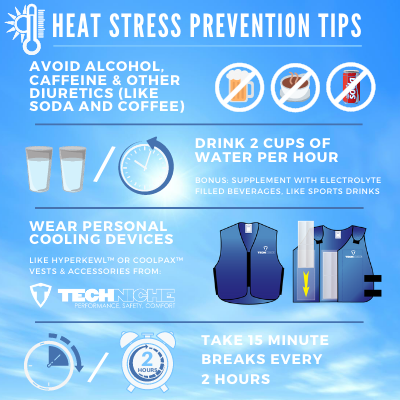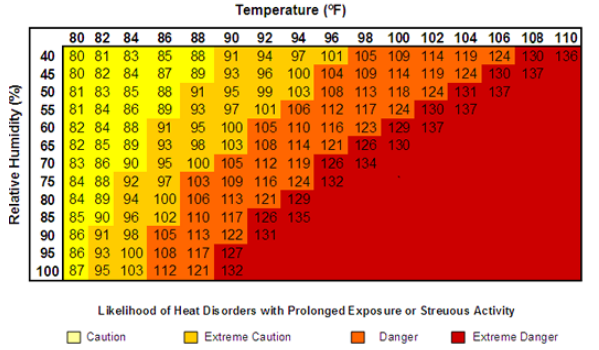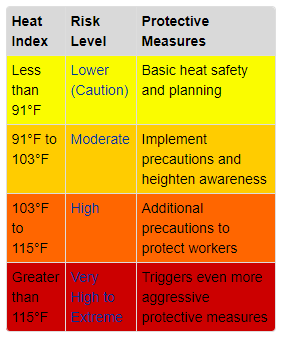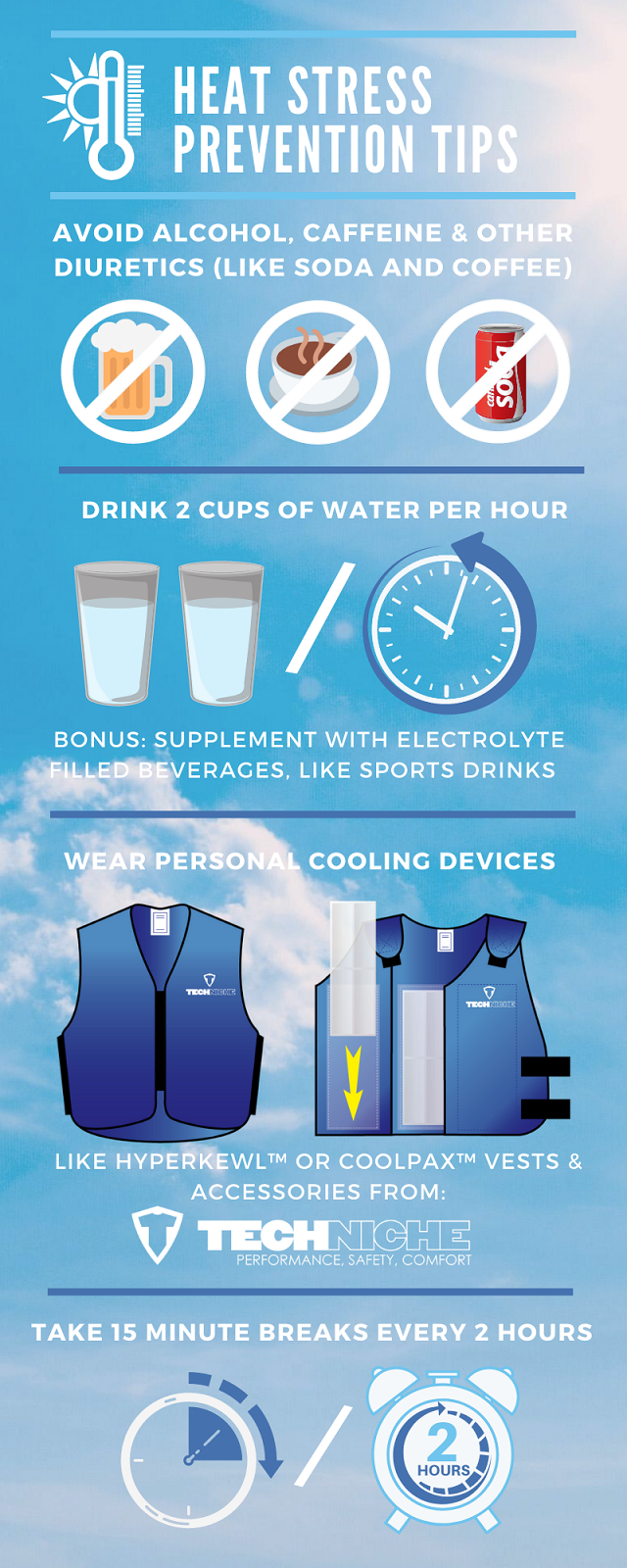Heat Stress and Worker Safety
06 August 2020

What is Heat Stress?
Heat stress occurs when our body becomes overheated and is unable to cool itself down enough to keep a healthy temperature.Heat can be generated internally through muscle use or externally by the environment, or a combination of the two. Heat stress can lead to other problems such as, heat exhaustion, heat stroke, heat cramps, or heat rash. The body has three natural mechanisms to defend itself from the heat: Breathing, sweating, and changing blood flow; however, sometimes these defense mechanisms are not enough, and the body’s temperature continues to rise.
The U.S. National Oceanographic and Atmospheric Administration (NOAA) Heat Index:

Many occupations require workers to be exposed to environments of high heat, in both indoor and outdoor settings. Unfortunately, “[e]very year thousands of workers become sick from occupational heat exposure, and some are fatally injured (osha.gov)”. The CDC reports an average of 658 American deaths each year, due to extreme heat.
Working in hot conditions leave workers at risk to heat related illness and can cause them to be slower and less productive. According to NASA, when temperatures reach 95 degrees Fahrenheit, a person’s output drops by 45%.
Preventing heat stress, can protect workers health, improve worker safety, and increases worker productivity!

Who is more susceptible to Heat Stress?
Infants, children up to 4 years of age, people 65 and older, overweight individuals, or those with existing medical conditions, such as diabetes and heart disease.
BE PROACTIVE:
Take precautions, like the following, to reduce the chances of severe heat related illnesses:
- Drink plenty of water and electrolytes. -It is recommended to drink a ½ quart of water per hour (that is equivalent to: 1 Pint per hour, or 2 cups per hour, or 16 Fl oz per hour)
- Sip water many times throughout the day (every 15 mins), rather than gulp down lots of liquids fewer times per day.
- Avoid beverages that contain alcohol, soda, caffeine or other diuretics
- Wear loose-fitting lightweight, light colored clothing
- Wear head gear that provides shade
- Try to eat fewer warm foods, and more cooler foods
- Take 10-15 minute breaks every 2 hours
- Use cooling fans or other personal cooling devices, such as cooling vests Use technology like HyperKewl (http://www.techniche-intl.com/technologies/hyperkewl/) in conditions with high airflow and lower humidity Use Technology like CoolPax (http://www.techniche-intl.com/technologies/coolpax/) in conditions with high humidity, low to no airflow, and under protective gear (PPE) , such as welding suits.
What Employers can do to help reduce the chances of heat related illness:
- Provide cold beverages (water and/or sport drinks)
- Provide rest breaks and water breaks in cool areas
- Provide heat stress training to employees and supervisors. Including information about prevention, symptoms and what to do in the event of an emergency
- Provide protective attire, such as cooling vests and accessories
- Provide technology like HyperKewl (http://www.techniche-intl.com/technologies/hyperkewl/) in conditions with high airflow and lower humidity
- Provide Technology like CoolPax (http://www.techniche-intl.com/technologies/coolpax/) in conditions with high humidity, low to no airflow, and under protective gear (PPE) such as welding suits.
- When possible, provide fans or other means to circulate airflow
- When possible schedule work when the temperature is cooler (i.e. Early mornings)
- Be sure to allow workers to take 10-15 minute breaks every two hours
- Acclimatization: start new workers, that are not used to working in the heat, at 50% of the normal workload and time exposed to the heat for their first day, and gradually build up to 100% by the fifth day.

WHAT CAN TECHNICHE DO?
Techniche is committed to reducing the risk of heat stress in the workplace. Our wearable cooling products are designed to target key areas of the body in order to cool the wearer and reduce the risks of working at high temperature.
If all attempts fail at preventing Heat related illnesses, here is a list of the most common signs and symptoms and what to do if a worker becomes a victim:
Heat stroke: Occurs when the body becomes unable to regulate its core temperature. Sweating mechanism fails and the body can no longer dispel excess heat. Heat stroke may result in permanent disability or death if not treated immediately. Heatstroke is fatal in 80% of cases.
Common Signs and Symptoms include: Confusion, altered mental status, slurred speech, loss of consciousness, Seizures, hot dry skin.
What to do:
- Call 911 for emergency care (Stay with victim until care arrives).
- Move victim to a shaded or cool area
- Remove outer clothing or soak clothing in cool water
- Place cold clothes on head, neck, armpits and groin area
- Circulate the air around the victim
- Do Not give the victim fluids
- If the victim is unconscious, lay them on their side and clear their airway
Heat cramps: Painful muscle spasms that occur when the body is depleted of salt and moisture.
Common Signs and Symptoms include: Muscle cramps, pain, or spasms. (Most commonly in the abdomen arms or legs.) These can occur during or after work.
What to do:
- Stop activity immediately
- Move victim to a cool place
- Victim should drink water and a snack (Preferably a carbohydrate-electrolyte replacement liquid) every 15 to 20 minutes.
- Rest several hours before returning to activity
- Medical attention is needed if the victim has heart problems or is on a low sodium diet, or if cramps continue after 1 hour.
Heat Syncope/Fainting: an episode of dizziness usually occurring with a prolonged standing or sudden rising from a sitting or lying position. Most common in those that are not used to working in warm conditions.
Common Signs and Symptoms include: Brief loss of consciousness, dizziness, light-headedness, sweaty skin with normal body temperature, and no signs of heat stroke or heat exhaustion
What to do:
- Sit or lie victim down in a cool place
- If completely conscious, victim should slowly drink water, clear juice or an electrolyte drink (Sport drink)
- Medical attention may be necessary if symptoms persist after lying down
Heat exhaustion: Occurs when the body loses too much water and salt, usually due to excessive sweating and not consuming enough fluids. (Most commonly occurs in high temperatures with high humidity and strenuous activities).
Common Signs and Symptoms include: Excessive sweat, weakness or fatigue, pale clammy skin (Sometimes flushed), headache, nausea, dizziness, irritability, thirst, elevated body temperature.
What to do:
- Move victim to a cooler environment
- If fully conscious, have victim drink an electrolyte solution (sport drink) and avoid caffeine
- Cool the victim with cool water or cold compress.
- Circulate air around victim
- Seek medical attention if vomiting or fainting occurs, or if symptoms persist for more than 30 minutes
References:
-
“CDC - Heat Stress - Heat Related Illness - NIOSH Workplace Safety and Health Topic.” Centers for Disease Control and Prevention, Centers for Disease Control and Prevention, 6 June 2018, www.cdc.gov/niosh/topics/heatstress/heatrelillness.html.
-
Department of Health & Human Services. “Heat Stress and Heat-Related Illness.” Better Health Channel, Department of Health & Human Services, 26 Nov. 2015, www.betterhealth.vic.gov.au/health/healthyliving/heat-stress-and-heat-related-illness.
-
Flouris, Andreas D, et al. “Workers’ Health and Productivity under Occupational Heat Strain: a Systematic Review and Meta-Analysis.” The Lancet Planetary Health, Elsevier, 4 Dec. 2018, www.sciencedirect.com/science/article/pii/S2542519618302377.
-
“Heat Stress Facts.” Princeton University, The Trustees of Princeton University, ehs.princeton.edu/workplace-construction/occupational-health/heat-cold-stress/heat-stress-facts.
-
“Heat Stress.” NASD, nasdonline.org/137/d001702/heat-stress.html.
-
“Understanding the Dangers of Heat Stress.” Safety+Health Magazine, Safety+Health Magazine, 25 June 2017, www.safetyandhealthmagazine.com/articles/15818-understanding-the-dangers-of-heat-stress.
- “UNITED STATES DEPARTMENT OF LABOR.” Occupational Safety and Health Administration, www.osha.gov/SLTC/heatstress/.
MEDICAL DISCLAIMER:
This article is not intended for the purpose of providing medical advice All information, content, and material of this website is for informational purposes only and are not intended to serve as a substitute for the consultation, diagnosis, and/or medical treatment of a qualified physician or healthcare provider.
Medical emergency If you have a medical emergency, call your doctor or 911 immediately.
General website information the information contained in this website is not intended to recommend the self-management of health problems or wellness. It is not intended to endorse or recommend any particular type of medical treatment. Should any reader have any health care related questions, promptly call or consult your physician or healthcare provider. No information contained in this website should be used by any reader to disregard medical and/or health related advice or provide a basis to delay consultation with a physician or a qualified healthcare provider.
You should not use any information contained in this website to initiate use of dietary supplements, vitamins, herbal and nutritional products or homeopathic medicine, and other described products prior to consulting first with a physician or healthcare provider. The wright group disclaims any liability based on information provided in this website.